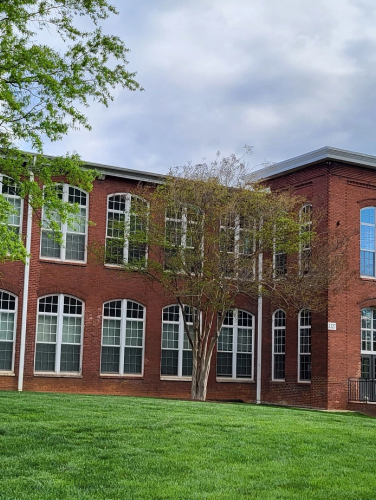
Mecklenburg Mill
(ca. 1905)
North Charlotte’s second textile mill once consumed a million pounds of cotton per year to produce its printed cotton.
3325 and 3327 N. Davidson St., Charlotte, NC 28205
Built between 1903 and 1905 on the main line of the Southern Railway, the Mecklenburg Mill opened in the midst of Mecklenburg County's heyday as the number two textile manufacturing county in North Carolina. The building has retained much of its original early 20th century and is one of Charlotte's best-preserved early textile mills.
Property Quick Links
The North Charlotte mill district began in 1903 around the Highland Park #3 mill, North Carolina's largest mill when it opened in 1904. It eventually attracted three more major mills, workers' housing, and a commercial area to North Charlotte, as well as several smaller textile-related concerns such as the Grinnell Company factory, a leading supplier of sprinkler fire-prevention systems for mills. On March 18, 1903, less than one month after plans for Highland Park #3 were announced, Charlotte investors Robert L. Tate and S. B. Alexander, Jr., along with Durham’s B. Lawrence Duke (of the famous North Carolina tobacco family), chartered the Mecklenburg Cotton Mills Company. Two months later, the owners of Highland Park #3 sold the Mecklenburg Mill founders land for a mill and village, to be located north of the Highland Park #3 plant.
The Mecklenburg Mill facility opened in the summer of 1905. The main feature of the mill was a two-story building where carding took place in the basement, spooling, warping and weaving on the first floor, and spinning on the second. A one-and-a-half-story boiler room wing was attached to the north side of the building, and a separate wooden one-story cotton warehouse stood south of the building. The mill village, composed of one-story wooden single-family cottages, stretched out along what are now East 37th Street and Mercury Street in front of the building. Just north of the village was a mill pond (now drained) that supplied water to a tall, freestanding steel water tower in front of the mill that in turn fed the factory's Grinnell sprinkler system.
As of 1910, Mecklenburg Mill had 12,000 spindles, 300 looms, and twenty-six cards, ranking it among Charlotte's mid-sized textile factories. A 450 horsepower steam engine powered the plant. The Mecklenburg Mill consumed a million pounds of raw cotton per year and produced printed cloth sold through J.P. Stevens & Company of Boston and New York. Not long after its opening, the mill began having financial troubles. There was frequent turnover among its principal stockholders in the late 1910s and early 1920s, and the company declared bankruptcy in October 1923. Bought in foreclosure by a Delaware corporation in July 1926, the facility became known as Mercury Mill, a name that stuck with the building despite a string of subsequent purchasers: Martel Mills in 1929, Johnston Mills Company (headquartered in the 16-story Johnston Building in downtown Charlotte) in the early 1940s, and Gastonia’s Chavis Textile Manufacturing of Gastonia in 1975 following the mill’s closure in 1969.

